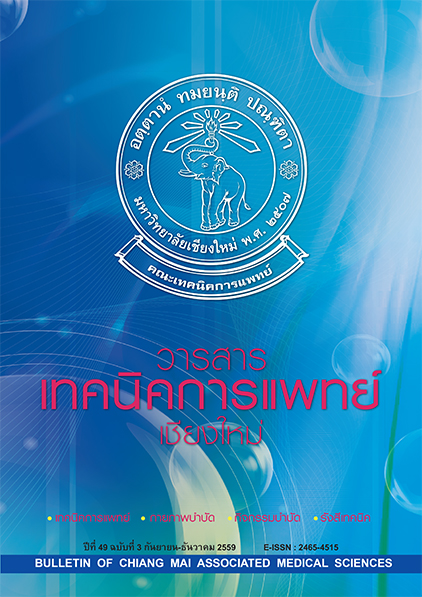Effectiveness of double dose in single donor platelet preparation by the automated blood cell separators in continuous and intermittent flow system
Main Article Content
Abstract
Background: To prepare single donor platelet (SDP) with good quality and sufficient quantity, beside safety to donors and patients, efficient and less costly automate blood cell separators also be considered.
Objectives: To study the double-dose SDP products prepared from two automated blood cell separators having different principles. To compare platelet products in donors before, immediately after donation, and two weeks after donation. To evaluate change of average cost after double dose SDP preparation was implemented.
Materials and methods: Semi-randomized study was performed in double-dose platelet donor (2 groups of 45 donors) in Blood Bank Unit, Phare Hospital during March to September 2015. Two automated blood cell separators, continuous flow: Trima Accel® and intermittent flow: Haemonetics MCS plus /UPP® systems were compared in terms of platelet products, pre/post-count platelets and hematologic values before, immediately, and two weeks after donation. Operation and efficiency of machine as well as average cost per dose of SDP preparation in 2013–2015 were also studied.
Results: Quality and yield of platelet products obtained from Trima Accel® were significantly greater than those from Haemonetics MCS plus/UPP®; volume 444.0±41.5 mL, platelet yield 6.2±0.6x1011 cells, platelet 11.4±1.2 units for Trima Accel® and volume 385.1±87.1 mL, platelet yield 5.5±0.7x1011 cells, platelet 9.6±2.2 units for Haemonetics MCS plus/UPP® (p<0.001). After two weeks of donation, donors using Trima Accel® had significantly higher post-count platelet than those of Haemonetics MCS plus/UPP®. Collection efficiency of Trima Accel® was significantly higher than Haemonetics MCS plus/UPP® (p=0.042). Processing time per procedure of Trima Accel® and Haemonetics MCS plus/UPP® was averagely 82.3±13.7 minutes and 85.6±21.6 minutes, respectively, with no statistical significance. In 2015, cost per dose of SDP preparation for patients in Phrae Hospital decreased to 24.7% after increasing double dose SDP products to 34.8%.
Conclusion: Platelet yield products from Trima Accel® was superior to those from Haemonetics MCS plus/UPP®. After two weeks, double dose SDP donors donated by Trima Accel® had increased post-count platelets, suggesting that repeat donation can be done before four weeks. Both blood cell separators has no difference in processing time per procedure and double dose SDP preparation decreased cost of management.
Bull Chiang Mai Assoc Med Sci 2016; 49(2): 400-411. Doi: 10.14456/jams.2016.28
Article Details

This work is licensed under a Creative Commons Attribution-NonCommercial-NoDerivatives 4.0 International License.
Personal views expressed by the contributors in their articles are not necessarily those of the Journal of Associated Medical Sciences, Faculty of Associated Medical Sciences, Chiang Mai University.
References
2. Eerisse JG, Brand A. Prevention of platelet refractoriness due to HLA antibodies by administration of leukocytes-poor blood components. Exp Hematol 1981; 9: 77-83.
3. American Association of Blood Banks. Standards for Blood Banks and Transfusion Services. 24th ed. Bethesda: Maryland; 2006.
4. Kongruksa R. Study of the reduced white blood cells Single Donor Platelet preparation by the automate blood cell separator [thesis]. Bangkok: Mahidol University; 2005.
5. Bueno JS, Garcia F, Castro E, Barea L, Gonzalez R. A randomized crossover trial comparing three plateletpheresis machines. Transfusion 2005; 45: 1373-81.
6. Suresh B, Arun R, Yashovardhan A, Deepthi K, Sreedhar Babu KV, Jothibai DS. Changes in pre- and post-donation haematological parameters in plateletpheresis donors. Clin Sci Res 2014; 3: 85-9.
7. Katz L, Palmer K, McDonnell E, Kabat A. Frequent plateletpheresis does not clinically significantly decrease platelet counts in donors. Transfusion 2007; 47: 1601-6.
8. National Blood Centre, Thai Red Cross Society. Standards for Blood Banks and Transfusion Services. 4th ed. Bangkok; 2015.
9. Guerrero-Rivera S, Gutiérrez-Espíndola G, Talavera JO, Meillón-García LA, Pedraza-Echevarría M, Pizzuto-Chávez J. Hemoglobin and platelet count effect on platelet yields in plateletpheresis. Arch Med Res 2003; 34: 120-3.
10. Richa E, Krueger P, Burgstaler EA, Bryant SC, Winters JL. The effect of double- and triple-apheresis platelet product donation on apheresis donor platelet and white blood cell counts. Transfusion 2008; 48: 1325-32.
11. U.S.Food and Drug Administration, Center for Biologicals Evaluation and Research (CBER) [Internet]. Rockville (MD); c 1988 [updated 2005] (Cited Jan 2015). Available from: http://www.fda.gov/cber/gdlns/plateletauto.htm/
12. Popovsky MA. Multicomponent apheresis blood collection in the United States: Current status and future directions. Transfus Apher Sci 2005; 32: 299-304.
13. Kongruksa R, Kupatawintu P, Sombatnimitsakul S, Nathalang S. Comparison of Apheresis Platelets Leukocytes Reduced Prepared with Trima Accel and Haemonetics MCS Plus Cell Separator. Hematol Transf Med 2008; 18: 199-205.
14. Murphy S. Preservation and Clinical use of Platelets. In: Beutler E, Lichtman MA, Coller BS, Kipps TJ, editors. Williams Hematology. 6th ed. New York: McGraw-Hill; 2001. p. 1905-16.
15. Burkhardt T, editor. Validation of UPP Protocol introducing 17G needles for Platelets in Plasma collection in German Red Cross. Kuala Lumpur; 2013.
16. Patidar GK, Sharma RR, Marwaha N. Frequency of adverse events in plateletpheresis donors in regional transfusion centre in North India. Transfus Apher Sci 2013; 49: 244 -8.
17. Philip J, Sarkar RS, Pathak A. Adverse events associated with apheresis procedures: Incidence and relative frequency. Asian J Transfus Sci 2013; 7: 37-41.
18. Picker SM, Radojska SM, Gathof BS. Prospective evalution of double RBC collection using three different apheresis system. Transfus Apher Sci 2006; 35: 197-205.
19. Moog R. Feasibility and safety of triple dose platelet collection by apheresis. Clin Apher 2009; 24: 238-40.
20. Van der Meer PF. Apheresis versus whole-blood-derived platelets: pros and cons. ISBT Sci Ser 2012; 7: 112-6.
21. Bowden RA, Slichter SJ, Sayers M, Weisdorf D, Cays M, Schoch G, et al. A comparison of filtered leukocyte-reduced and cytomegalovirus (CMV) seronegative blood products for the prevention of transfusion associated CMV infection after
22. bonemarrow transplant. Blood 1995; 86: 3598-603.
23. Prachayasittikul V, Plabplueng (Daosukho) C, Treeratanapiboon L, Jangpatarapongsa K, Phopin K, Nuchnoi P, et al. Challenging trends of Medical Technologist toward health caring in the 21st Century. Bull Chiang Mai Assoc Med Sci 2016; 49: 1-9.


